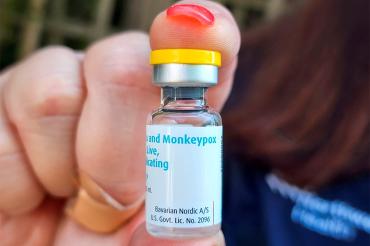U of T expert Kerry Bowman on monkeypox and the danger posed by zoonotic diseases

Published: July 28, 2022
The World Health Organization recently declared monkeypox – a disease that’s been a concern in African countries for years – a global public health emergency.
Monkeypox has been spreading globally in recent months with 75 countries reporting cases.
 Yet, while the WHO issued its highest level of alert, that doesn’t mean monkeypox is highly contagious or necessarily lethal, says Kerry Bowman, assistant professor in the department of family and community medicine in the Temerty Faculty of Medicine and the School of Environment at the Faculty of Arts & Science.
Yet, while the WHO issued its highest level of alert, that doesn’t mean monkeypox is highly contagious or necessarily lethal, says Kerry Bowman, assistant professor in the department of family and community medicine in the Temerty Faculty of Medicine and the School of Environment at the Faculty of Arts & Science.
“It doesn’t mean we’re facing a situation like COVID-19,” says Bowman. “[But] I think it’s a good decision. It’s been in Africa for some time, and it is now emerging in new parts of the world.”
A joint research effort by the university and partner hospitals – including University Health Network, Sunnybrook Research Institute and Unity Health Toronto – is underway to study the global monkeypox outbreak. The team’s findings will help inform a public health response to the outbreak in Canada and support efforts in other countries where the virus is endemic.
U of T News recently spoke with Bowman about the WHO’s designation of monkeypox as a global health emergency, how that might change the international response to the outbreak and what can be done to address the rise of zoonotic diseases more generally.
What does the WHO designation mean?
What it means is that we we've got a disease of concern that’s spreading globally. There’s no question about that. It does not necessarily mean that this is highly contagious or that it’s highly lethal. You might remember the WHO did this for Zika, which may not have had implications for many of us.
So, it doesn’t mean that we’re facing another situation like COVID-19. The WHO was fairly divided on whether it was necessary to trigger the highest level of alert. But I think it’s a good decision. It’s been in Africa for some time, and it is now emerging in new parts of the world.
How might the global response to monkeypox change with this new designation?
What it could mean in the future is travel warnings and restrictions. People coming from countries with a high prevalence of monkeypox, which is the United States and parts of the European Union right now, could experience higher screening at airports. If a person is unwell and officials suspect it is monkeypox, they could order quarantine or containment. I stress the word “could” in this scenario.
I hope it will encourage countries like Canada to get moving on monkeypox before it really takes root – to get ahead of it in terms of vaccination and vaccination supply. From a public health point of view, it’s important to make sure that this can be curtailed before it becomes something that’s endemic here.
What more could be done to lower the risk of transmission?
Vaccine access and education is huge. At this point, it should be readily available, and people should decide for themselves whether they want it or not.
The other concern I have is that until very recently our leaders are being opaque on how much vaccine we have, what our situation is with vaccine and what our plans are with it. Democracy and public health should never be opaque. You really need to let the public know what we’re dealing with.
Right now, it’s not clear as to what our vaccine supplies are and whether we have enough longer term. It’s still a very slow, inconsistent process to receive vaccination.
One element I think we’re ignoring on a global level is: where are all these awful diseases coming from? Monkeypox, without question, has an environmental and climate change component to it. It's not the only factor, but it's clearly a contributing factor. We continue not to look at the upstream causes of zoonotic diseases – diseases that come from animals just as this did.
Can you expand on that?
There’s a connection related to climate change and biodiversity loss that we’re simply ignoring.
What’s happening is, as more and more forests are cut down and the climate changes in Africa and other tropical regions, you have more non-human species moving around and being hunted. The interaction between animals and people is rising as there’s both environmental degradation and habitat loss. We’re opening up more tracts of what was once pristine forest and exposing people to those viruses.
The number of zoonotic diseases that are rising is significant.
How can we address this?
In the early days of the COVID-19 pandemic, we had some awareness of this – but there’s next to nothing being done to prevent more of these diseases from emerging.
It’s a real shortcoming of Western medicine that we have these firewalls where we don’t cross over into anything environmental. It’s the way we’ve organized ourselves – to our determent.
We need much more of a “One Health” approach. One Health and planetary health is something that looks at how all these systems work together – human, non-human and biodiversity.
In national and global planning, we should be looking at the consequences of mass deforestation in equatorial regions. We should also look at the health and wellbeing of ecosystems within Canada and the health of the animals.
For human health to flourish, we need to look through the lens of our environmental parameters.



